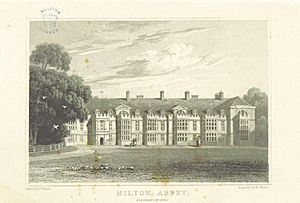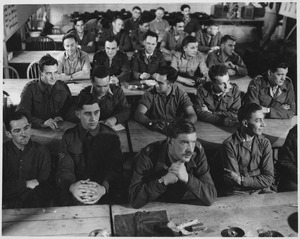Milton Hall facts for kids
Milton Hall, located near Peterborough in Cambridgeshire, England, is the largest private house in the county. It has been the historical home of the Fitzwilliam family since 1594. The house sits within a large park where some old oak trees from a much older Tudor deer park still stand. Milton Hall is considered a very important historical building, known as a Grade I listed building. Its garden is also historically important, listed as Grade II*.
Contents
Location of Milton Hall
The beautiful gardens and grounds of Milton Park are about 3 miles (5 km) from Peterborough city centre. They cover about 35 acres (14 hectares) to the south of the house. You can see the park from both sides of the Hall. The house and its grounds are private, so they are not open to the public. However, the Peterborough Milton Golf Club has a golf course set within the estate, offering views of Milton Hall as you play.
History of Milton Hall
In the Middle Ages, Milton was a small village near Castor. In 1502, a rich merchant named Sir William Fitzwilliam bought the land. He was knighted in 1515.
The oldest parts of Milton Hall were built in the 1590s by Sir William's grandson, William Fitzwilliam. He was an important leader in Ireland and also started to design the gardens. His son, the fourth William, took over in 1599 and continued working on the Hall and its landscape. A map from 1643 shows that the grounds at this time had a moat, courtyards, fishponds, orchards, and gardens.
Later, the third Baron Fitzwilliam became an Earl. Around 1690, he added the impressive stables, designed by architects William Talman and John Sturges. His son, John Fitzwilliam, the second Earl, continued to enlarge the park and change the gardens in the 1720s.
John's son, William, the third Earl, began to update the Hall in 1750 with architect Henry Flitcroft. A new south front was added. After the third Earl died in 1756, Sir William Chambers finished the work for his son, William, the fourth Earl, in 1773. The fourth Earl later inherited another large estate, Wentworth Woodhouse, which became his main home. He would only come to Milton in the winter for hunting. To make this easier, he asked Humphry Repton, a famous landscape designer, for advice on improving the park in 1791.
The fourth Earl passed away in 1833. His son, the fifth Earl, gave Milton Hall to his younger son, George Wentworth-FitzWilliam, in 1857. George lived at Milton for many years.
Milton Hall During the World Wars
Milton Hall was used by the military during both World Wars. In the First World War, it became a hospital to help wounded soldiers. During the Second World War, parts of the house and stables were used by the Czechoslovakian army. Later, the Special Operations Executive (SOE), a secret British organization, trained there. These agents trained in the grounds and woods before being parachuted into France to help prepare for the D-Day landings.
After the war, Lord and Lady Fitzwilliam returned to live at Milton Hall. The estate later passed to Sir Philip Naylor-Leyland, 4th Baronet.
Milton Hall and Daphne du Maurier
In 1917, when Milton Hall was a hospital, the famous writer Daphne du Maurier visited the house several times as a ten-year-old girl. She later wrote to the 10th Earl Fitzwilliam, saying that the happiness and freedom she felt during these visits greatly influenced her. She explained that when she wrote her famous novel Rebecca 20 years later, the inside of the fictional house, Manderley, was based on her memories of Milton Hall's rooms and its grand feeling during the First World War. She even called Milton "dear old Milton" in her letters.
Milton Hall and Margaret Thatcher
During the Falklands War in 1982, the Prime Minister of the United Kingdom, Margaret Thatcher, and her husband Denis stayed overnight at Milton Hall. The next morning, she received a phone call telling her that the Royal Air Force had successfully bombed the airfield at Port Stanley in the Falkland Islands.
See also
 In Spanish: Milton Hall para niños
In Spanish: Milton Hall para niños




